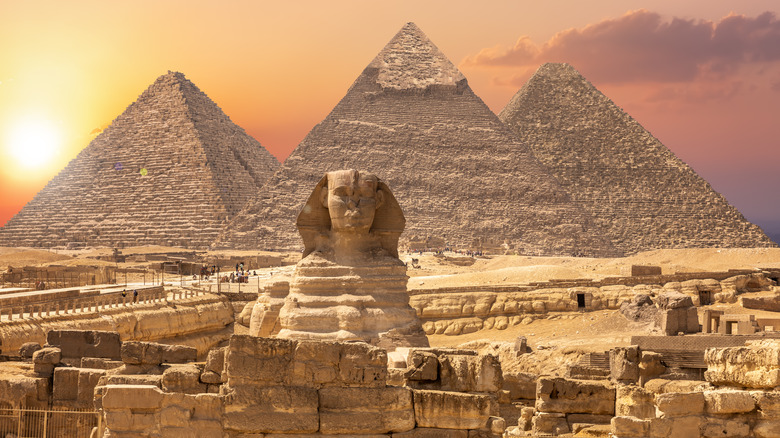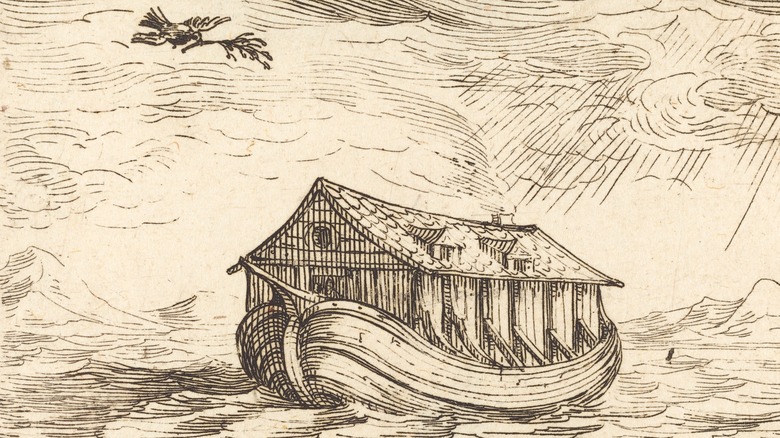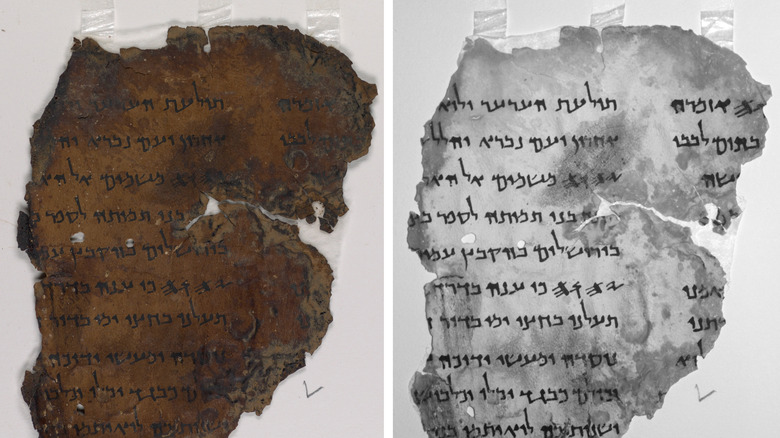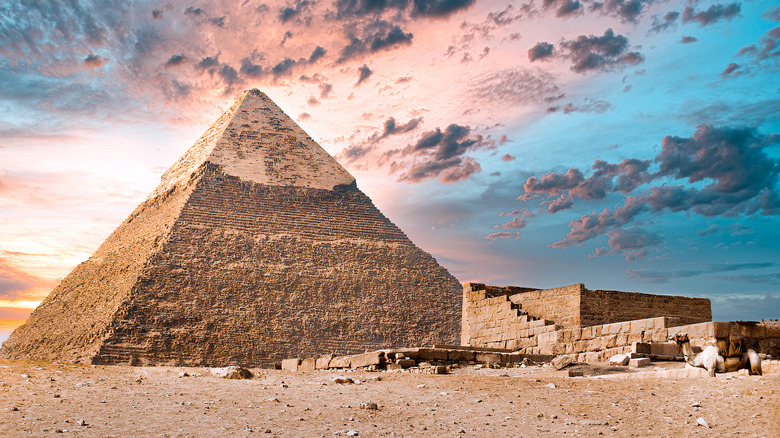This Theory Connects The Egyptian Pyramids To Noah's Ark
When it comes to the ancient world, people sure like to speculate. Perhaps because the events that occurred back then seem so utterly foreign to our modern minds, lots of armchair historians and casual conspiracy theorists like to devise intricate theories about ancient times. While history is certainly full of crazy true stories, some people like to come up with even more outlandish claims, which, however entertaining they may be, are probably not likely to be true.
One such historical area that gets a lot of attention is Ancient Egypt, perhaps in part because it is hard to fathom how such a great civilization could have grown without the help of modern technology like cars, power tools, or the use of Google. At the heart of these stories are the great Egyptian pyramids — the massive, impressive architectural feats that still seem intimidating. Constructing such precise, imposing buildings would be a difficult undertaking even today, let alone in a time without modern tools, so it is somewhat understandable that the pyramids tend to attract quite a few conspiracy theories of their own.
The Egyptian pyramids are magnets for wild theories
When people talk about the famous Egyptian pyramids, they are likely talking about the three Pyramids at Giza, which were constructed from around 2550 B.C. to about 2490 B.C., some 4,500 years ago, in honor of three ancient Egyptian pharaohs — Khufu, Khafre, and Menkaure — according to National Geographic. Yet, many history buffs have put forth all kinds of theories explaining how the pyramids were "really" built. Some of these ideas can be pretty out there, like the one involving aliens flying to Earth with advanced technologies to assist with the construction (via History).
While that theory is literally out of this world, there is another wild theory about the pyramids that starts a little closer to home. Most of us are probably familiar with the Bible story of Noah's Ark. In the Book of Genesis, God flooded the world to punish humanity for their wickedness, except for one righteous man, Noah. Instead, he was told to build an ark, onto which he would bring his family and two of each type of animal, to survive the flood (via Britannica). However, most of us probably don't see a connection between this story and the ancient pyramids of Egypt. But most of us are not the historian Matthew Sibson, who has made the bold claim that the Egyptian pyramids and Noah's Ark may actually be one and the same.
A new translation may have revealed Noah's Ark was pyramid-shaped
Matthew Sibson, who talks about his discoveries on his YouTube channel "Ancient Architects," which he began in 2017, devised this theory after a new scan of the Dead Sea Scrolls revealed what he considered a bombshell discovery. Per Express, the Leon Levy Dead Sea Scrolls Digital Library Project recently undertook a massive digitization project, scanning "tens of thousands of fragments of the scrolls" with a camera capable of taking pictures at a resolution 28 times higher than a traditional scan. As a result of these new, higher resolution pictures, text on some fragments that had been previously illegible could now be read. And in these newly legible texts, Sibson believed he found a secret that revealed that Noah's Ark might have really been a pyramid, or at least a metaphorical version of it.
"Before then, regarding the story of Noah's Ark, scholars had been unable to read a particular word following the Hebrew phrase 'the ark's tallness,' but the new scans revealed the word 'ne'esefat.' The translation of this word from Hebrew to English means gathered, which ... means that the ark's ribs were gathered at the top to form a shape of a pyramid," Sibson explained to Express. "A Greek translation of the Old Testament, which dates to the third century B.C., also describes the ark as pyramid-shaped, using a Greek verb that also has a similar meaning to 'gathered.'"
Sibson also believes the story may be a metaphor
While the Christian belief of the Bible Flood is that water literally covered the Earth, Sibson believes that the story of Noah's Ark might really be referring to a major flood that occurred in the Middle East. He also says that it is possible the text in the Dead Sea Scrolls may not be referring to a literal pyramid-shaped ark. Instead, the newly discovered translations could be alluding in a more loosely metaphorical way to the story of how Egyptians survived the flooding.
"Some scholars say that the Great Pyramid of Egypt was built to reflect the primeval mound that, according to Ancient Egyptian tradition, emerged from the expanse of primordial waters. This story is not thought to be literal, but could the Great Pyramid have actually been a structure to survive a flood? Maybe the Egyptian elites built their own primeval mount to escape an impending flood," the historian explained, per Express.
The Egyptian pyramids were constructed using sledges and ramps
While this may be an interesting theory, many other historians and Egyptologists have explained what they believe is the most likely way the pyramids were built. And no, it didn't involve aliens or Biblical arks — just old-fashioned ingenuity and a lot of hard work. The pyramids were likely constructed by using sophisticated planning, lots of manpower, and a complex ramp system. According to Smithsonian, ancient Egyptians would use copper tools to quarry stone, most on the Giza plateau. The huge stone blocks would then be placed onto sledges, which were then pulled up the pyramids via a steep ramp system.
"This system is composed of a central ramp flanked by two staircases with numerous post holes. Using a sled which carried a stone block and was attached with ropes to these wooden posts, ancient Egyptians were able to pull up the alabaster blocks out of the quarry on very steep slopes of 20% or more," Yannis Gourdon, co-director of a joint archaeological mission at Hatnub, an alabaster quarry site in the Eastern Desert, explained to Live Science. Of course, historical discoveries are always being made, so there is always a chance a new finding will shine even more light on how these massive wonders were constructed. Yet, these explanations probably make more logical sense than theories claiming that Noah's Ark was really a pyramid.




